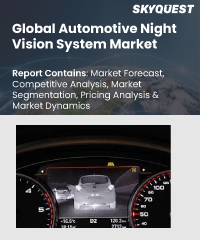
Product ID: SQMIG45E2171

Report ID:
SQMIG45E2171 |
Region:
Global |
Published Date: March, 2024
Pages:
197
|
Tables:
59 |
Figures:
75
Global Automotive Night Vision System Market size was valued at USD 3.71 Billion in 2022 and is poised to grow from USD 4.12 Billion in 2023 to USD 9.57 Billion by 2031, at a CAGR of 11.10% during the forecast period (2024-2031).
The increasing focus on improving road safety, particularly during low-light conditions, has driven the demand for advanced driver assistance systems (ADAS), including automotive night vision systems. These systems provide enhanced visibility, enabling drivers to detect and react to potential hazards such as pedestrians, animals, and objects beyond the reach of conventional headlights. One of the key drivers of market growth is the rising awareness about the importance of road safety. Governments and regulatory bodies across the globe are implementing stringent safety norms, compelling automotive manufacturers to integrate advanced safety features in their vehicles. As a result, automotive night vision systems are gaining traction as a crucial component of ADAS, contributing to the overall market growth. Moreover, technological advancements have significantly improved the performance and affordability of automotive night vision systems.
The development of high-resolution cameras, thermal imaging sensors, and sophisticated image processing algorithms has enhanced the detection capabilities and reduced false alarms. These advancements have made night vision systems more accessible to a wider range of vehicle segments, further propelling market growth.
In terms of regional dynamics, developed economies such as North America and Europe have witnessed substantial adoption of automotive night vision systems. The presence of stringent safety regulations, high disposable income, and a well-established automotive industry are the key factors driving market growth in these regions. Additionally, emerging economies in Asia Pacific, including China and India, are witnessing a surge in the demand for luxury vehicles and the adoption of advanced safety technologies, thus presenting significant growth opportunities for the automotive night vision system market.
US Automotive Night Vision System Market is poised to grow at a sustainable CAGR for the next forecast year.
Our industry expert will work with you to provide you with customized data in a short amount of time.
REQUEST FREE CUSTOMIZATIONWant to customize this report? This report can be personalized according to your needs. Our analysts and industry experts will work directly with you to understand your requirements and provide you with customized data in a short amount of time. We offer $1000 worth of FREE customization at the time of purchase.

Product ID: SQMIG45E2171